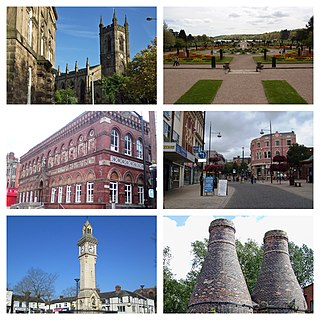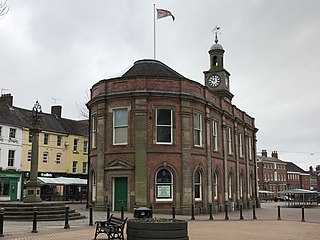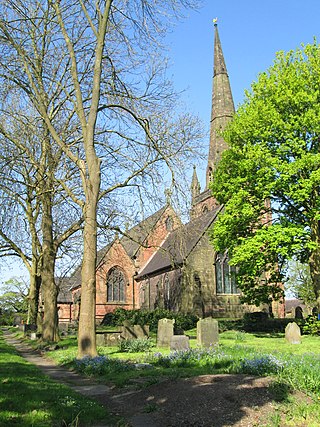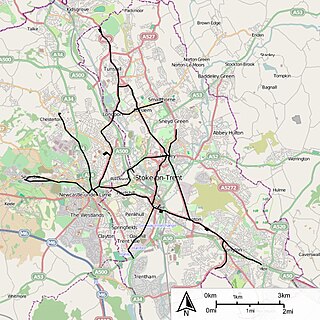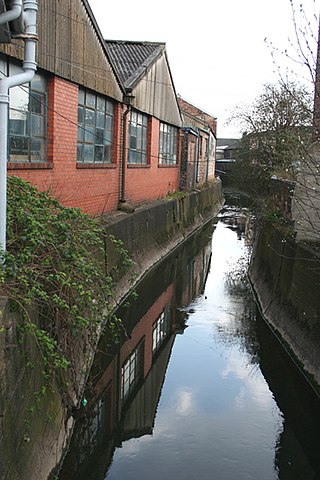History
The Roman road of Rykeneld Street from Wolstanton to Stoke would have run through Basford.
Basford's lofty position was first served by a 1759 turnpike road which was called "Fowlea Bank" by the 1770s, the name referring to the Fowlea Brook which runs through nearby Etruria and has formed the valley. [1] This old road still exists today, complete with its steep 1 in 8 gradient, surmounted by the substantial "Queen's Arms Inn" first built in 1769. After descending this bank, the crossing of the Fowlea into Etruria was then often a matter of fording the swampy valley bottom. This may have given rise to the later recorded name of Basford, being a local conflation of 'Bank' and 'Ford'.
In 1828 an easier 1 in 14 deep road cutting was made a short distance from the old road, and thereafter this became the main road linking Etruria with Wolstanton and Newcastle-under-Lyme. The banked footings of the base of this new road swept very high above the Fowlea Brook, ensuring easy passage across the valley bottom in all weathers. The new bank began to being referred to in documents as "Basford Hill" or "Basford Bank" by the 1830s. [1]
Due to abundant well-drained clay all along the valley ridge, tile and brick making is documented here as far back as the late 1600s. Rhead's book Staffordshire Pots and Potters (1906) found only a one-man water-pipe business in Basford at 1818, but noted traces of a possible early pottery: "... there were scattered foundations of what might have been a pottery in King's fields, with the remains of low arches as of oven or kiln 'mouths'." During the 1830s, the area along the base of the escarpment featured the full range of brick and tile yards and small ceramics manufactories, increasingly working at an industrial scale. [1] Despite this, substantial pockets of fields and woods persisted, notably the Etruria Woods. As late as 1929 aerial photography reveals large fields of corn and wheat being harvested directly alongside large tile-works at Basford. [2]
Basford Lawn Tennis Club was founded in 1883 and was originally sited on the present-day car park behind The Queen's Hotel (formerly the "Queen's Arms Inn"), but moved to its present location of West Avenue in 1926. The club hosted an exhibition match between Fred Perry and 'Bunny' Austin on 11 May 1936. [3]
From the 1890s onwards the area saw substantial development of vegetable growing allotments, many of which still exist today as large active allotment sites.
Hartshill and Basford Halt was a railway station located on the Market Drayton branch of the North Staffordshire Railway, and this enabled Basford people to travel to Newcastle-under-Lyme and Keele by train. The Halt closed in 1926.
The Potteries Loop Line local railway (Etruria to Kidsgrove) was closed by the notorious Dr. Beeching cuts in spring 1964. This meant it was no longer possible to travel from Etruria station to Hanley or Burslem by train.
In the 1970s a very major physical intervention in the geography of the area was the construction of the A500 road, running north–south along the escarpment bottom. This involved a complex new road interchange being built at the bottom of Basford Bank.
In 1986 Basford became home to Europe's first purpose-built theatre in the round, when the New Vic Theatre was built on the Newcastle-under-Lyme side of Basford. This replaced the nearby Victoria Theatre at Hartshill.
As some heavy industry became defunct, various open space regeneration and reclamation schemes were undertaken from the 1990s onwards. For instance, at Haydon Street there is now a large tree-edged playing field known as "Basford Open Space" which is now called "Basford Park". The field was once the site of industrial works, but has seen major reclamation and improvements, including a paved cycle-path. Another new feature of the area is the extensive and modern children's play area nicknamed "The Grum", on a former railway tunnel entrance between Victoria Street and the Shelton New Road, which now also includes sports features such as skate ramps and a basketball court.
The Etruria railway station, very near the foot of the Basford Bank and serving Basford, was closed to passengers in 2005.



